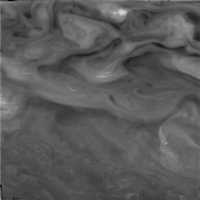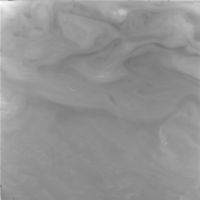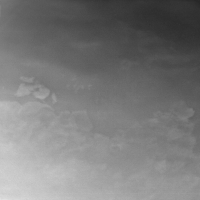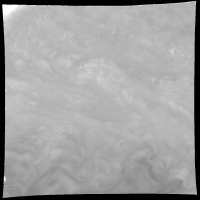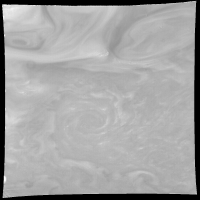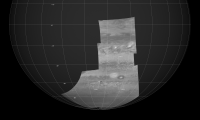Printable Version of Topic
Click here to view this topic in its original format
Unmanned Spaceflight.com _ Jupiter _ Cloud shadows on Jupiter?
Posted by: Bjorn Jonsson Jul 24 2010, 01:42 AM
When taking a look at some of the Voyager images of Jupiter I noticed something interesting in Voyager 1 image C1638201.IMQ - possible cloud shadows. I haven't seen them before on Jupiter in any spacecraft images. Here is a flat fielded, cleaned up and contrast stretched version of C1638201.IMQ:
At this time Voyager 1 was imaging equatorial and southern latitudes not far from the terminator which is to the right in this image. The possible cloud shadows are especially noticeable at lower right and near the image center. These features are more subtle but still noticeable without any contrast stretch or flat fielding:
C1638201.IMQ is a clear filter image obtained on 1979-03-05 06:08:36. The distance from Jupiter is 567,000 km according to the http://pds-rings.seti.org/tools/viewer2_jup.html at the PDS Planetary Rings Node. This yields a resolution of ~5 km/pixel.
There are more images obtained at a similar time that also seem to show shadows although this is the best example I have noticed so far.
If these are indeed cloud shadows (I can't see how this could be anything else) they must have been noticed before (they aren't that subtle) although I don't remember seeing cloud shadows mentioned before on Jupiter.
By the way the Voyager datasets for Jupiter are in my opinion still very interesting despite the Galileo and Cassini images. The resolution is much higher than in the Cassini images and there is far better time lapse stuff from Voyager than Galileo.
Posted by: tasp Jul 24 2010, 05:34 AM
Would that 3D process work on those images? Seems like if the shading was shadows, the software might do something, but IIRC, the software was designed for a solid surface, not a cloudscape . . .
Sorry, it's late and I am not sharp enough right now to find the right thread with the info.
Posted by: antipode Jul 24 2010, 07:33 AM
Wow - that's neat. Certainly looks like just the tops are reaching a level where they glaciate. What are the clouds made of at that level?
P
Posted by: machi Jul 24 2010, 11:24 AM
In fact Voyager images are better than Galileo images in terms of resolution. Best usefull images are at ~2.7 km/pix.
Posted by: machi Jul 24 2010, 11:46 AM
One of the best images of Jupiter from Voyager 1. Resolution is 2.65 km/pix.
In this image are very interesting clouds, they looks like flying icebergs.
Posted by: Phil Stooke Jul 24 2010, 12:52 PM
"Would that 3D process work on those images? Seems like if the shading was shadows, the software might do something, but IIRC, the software was designed for a solid surface, not a cloudscape . . ."
The software doesn't know what the surface is made of. Shape from shading certainly could do something with the clouds that show shadows. The varying shades among the background clouds may create artifacts, but albedo markings do that on solid surfaces as well.
Phil
Posted by: Bjorn Jonsson Jul 19 2017, 03:14 PM
I'm reviving this old thread because the Juno images have made it rather interesting. Many of the JunoCam images show cloud shadows and elevation differences but in the Voyager images cloud shadows are rare. Here are two more high resolution Voyager 1 images that are interesting when one has seen the Juno images. First narrow angle image C1638155. It has been enhanced and sharpened a bit:
This image shows some small, bright spots. They were probably difficult to interpret before Juno but a context image reveals that this is an image of a bright zone. Knowing what the bright zones look like in the Juno images these bright spots are very likely to be small, high altitude clouds. The resolution of the original image is ~5.5 km/pixel.
And narrow angle image C1638159, the processing is similar:
This image shows some cloud shadows above center and also left of center near the image edge. Below center a relatively small vortex is visible. Features of comparable size have been seen in more detail in some of the Juno images. Here the resolution is also ~5.5 km/pixel.
Below is a context image based on a simple cylindrical map created from several wide angle images obtained around the time of the above observations through various filters. The image shows the location of the two images above and also the location of the image in the first post of this thread. It's interesting to use this map to compare the features visible in the above images to features at comparable latitudes in the Juno images.
Posted by: JRehling Jul 20 2017, 07:12 PM
Very interesting; good work as usual!. The effect is certainly close to the threshold of detectability, but I think it's real. I suppose the competing, non-shadow interpretation would be that albedo features happen to place darker features on the anti-sun side of some brighter albedo features. It's hard to refute that with certainty; by definition, the brightest regions in an image will be surrounded by darker regions on all sides. The strength of the shadow interpretation would depend upon the candidate shadows being darker than the regions on the opposite, closer-to-subsolar side of the bright regions.
That applies here, but the margins are certainly tight, often just one pixel showing the darkness.
A real clincher would be if we had images of similar or identical regions ~4 hours apart, with the direction of illumination roughly reversed, and we saw the candidate shadows switch sides. Voyager's trajectory could never provide that sort of imagery because both Voyagers flew past the sunset boundary and were never close to having a favorable view of the sunrise boundary. Ditto for Cassini. And of course, Galileo had to skip a lot of imaging opportunities. So this is one particular investigation that Juno permits for the first time. Although I'd be very, very surprised if these Voyager images weren't showing shadows.
Posted by: scalbers Jul 20 2017, 08:32 PM
Post #1 in this thread is pretty impressive in its showing of shadows from Voyager. The cloud near the upper boundary looks much like a convective overshooting top on Earth.
Posted by: JRehling Jul 21 2017, 07:28 PM
I agree, Steve. It's interesting to think of the jovian equivalent of terrestrial weather patterns. Somewhere in that huge atmosphere, there may be cold fronts and/or low pressure centers triggering patterns of thunderstorms. I think we have yet to characterize it all, but these sure look like what you say.
Powered by Invision Power Board (http://www.invisionboard.com)
© Invision Power Services (http://www.invisionpower.com)
